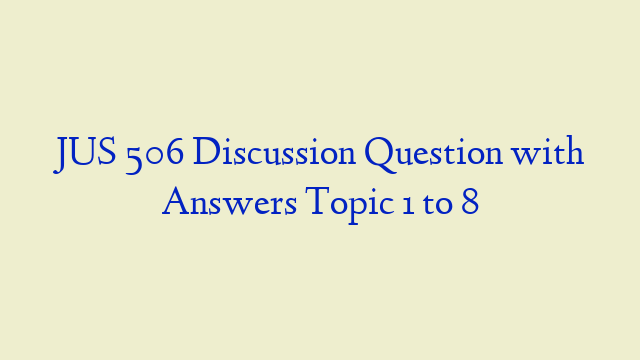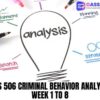Description
JUS 506 Topic 1 Discussion Question 1
Compare and contrast the consensus and conflict models of law and crime. Which model most closely fits with the ideological underpinnings of the U.S. justice system, and why?
JUS 506 Topic 1 Discussion Question 2
Describe the history of the U.S. justice system, and the principles it was founded upon. What changes do you see in today’s approach to crime and justice?
JUS 506 Topic 2 Discussion Question 1
Age, gender, social class, and race are all linked to criminal behavior. Choose one and explain the connection it has to crime as identified by research. Explain the implications this link has in preventing future crimes.
JUS 506 Topic 2 DQ 2
What are some methods of collecting crime data? What are the strengths and weaknesses of these methods?
JUS 506 Topic 3 DQ 1
Which theories do you believe better explain all types of crime—biological theories, or strain theories? Looking across the board, are criminals more likely to share biological characteristics (such as mental illness and increased levels of testosterone), or are they more likely to share social traits (being raised in broken homes, living in poverty, lacking education, etc.)? Be sure to cite the sources of your information or statistics.
JUS 506 Topic 3 DQ 2
Explain Shaw and McKay’s theory of social disorganization. Describe some of the physical, behavioral and economic effects of life in deteriorating neighborhoods. Assess how effective this theory is in explaining crime.
JUS 506 Topic 4 DQ 1
Travis Hirschi has been one of the most influential criminal theorists over the last 25 years. He asserts that there are four social bonds that can deter or encourage individuals to commit crime. What are those bonds, and which of the four do you believe is most lacking among at-risk juveniles today? Why?
JUS 506 Topic 4 DQ 2
Read “Are Human Beings Inherently Bad?” on page 182 and decide which theorist—Merton or Hirschi—has assumptions about the nature of human sin that best aligns with biblical principles. Explain that alignment.
JUS 506 Topic 5 DQ 1
According to the article by Kocsis and Palermo (2015), what characteristics have traditionally been used in creating offender profiles? What do the authors consider problematic when evaluating trait-based profiling?
JUS 506 Topic 5 DQ 2
Despite its glamorous Hollywood image, criminal profiling has a reputation for underperforming among criminologists and researchers. How might newer versions of criminal profiling that utilize modern technology change the game and be more effective in catching criminals?
JUS 506 Topic 5 DQ 1
Analyze Cohen and Felson’s routine activities theory. Is this theory able to fully explain all types of crime? Why or why not?
JUS 506 Topic 5 DQ 2
Lifestyle theories of victimization assert that changing roles and schedules in daily life affect the number of situations with high victimization risks that a person experiences. Describe lifestyles that are considered most at-risk versus those considered least at-risk for victimization. Do you believe crime preventive measures that use this type of theory and research are “blaming the victim” or simply using common sense to try to reduce an individual’s risk?
JUS 506 Topic 6 DQ 1
Analyze Cohen and Felson’s routine activities theory. Is this theory able to fully explain all types of crime? Why or why not?
JUS 506 Topic 6 DQ 1
Lifestyle theories of victimization assert that changing roles and schedules in daily life affect the number of situations with high victimization risks that a person experiences. Describe lifestyles that are considered most at-risk versus those considered least at-risk for victimization. Do you believe crime preventive measures that use this type of theory and research are “blaming the victim” or simply using common sense to try to reduce an individual’s risk?
JUS 506 Topic 7 DQ 1
Read the article, “What Propels Sexual Murderers: A Proposed Integrated Theory of Social Learning and Routine Activities Theories” and explain how and to what extent mental illness plays a role in violent criminal behavior.
JUS 506 Topic 7 DQ 2
Mass shootings have become an increasing concern among American criminologists. Read “Mass Shootings in America: Moving Beyond Newtown” and analyze the myths versus the reality of what we know to be true about this particular type of violent criminal behavior. What prevention techniques might be effective for potential mass shooters?
JUS 506 Topic 8 DQ 1
The pornography industry is one of the most lucrative in the nation— some estimates are that it grosses more than $4 billion annually—however, the women and girls who work in this industry see very little of that money. Prostitution as well is highly profitable for a growing number of pimps and human traffickers selling both women and children. What are the legal and moral differences between these two types of sex work, and how have changing social norms contributed to the legal status of both today?
JUS 506 Topic 8 DQ 2
Do some research on the problems associated with marijuana use, particularly in states where recreational marijuana is now legal. Recent studies have identified 1) a decrease in belief that marijuana is harmful, and 2) a significant increase in marijuana use specifically among children in 8th-10th grades. What are the implications of this research for other states proposing legislation that would legalize recreational marijuana? Do you believe marijuana should be legalized? Why or why not?



